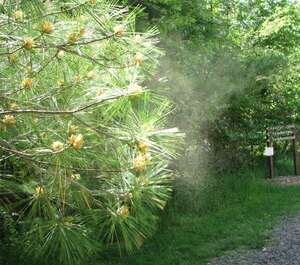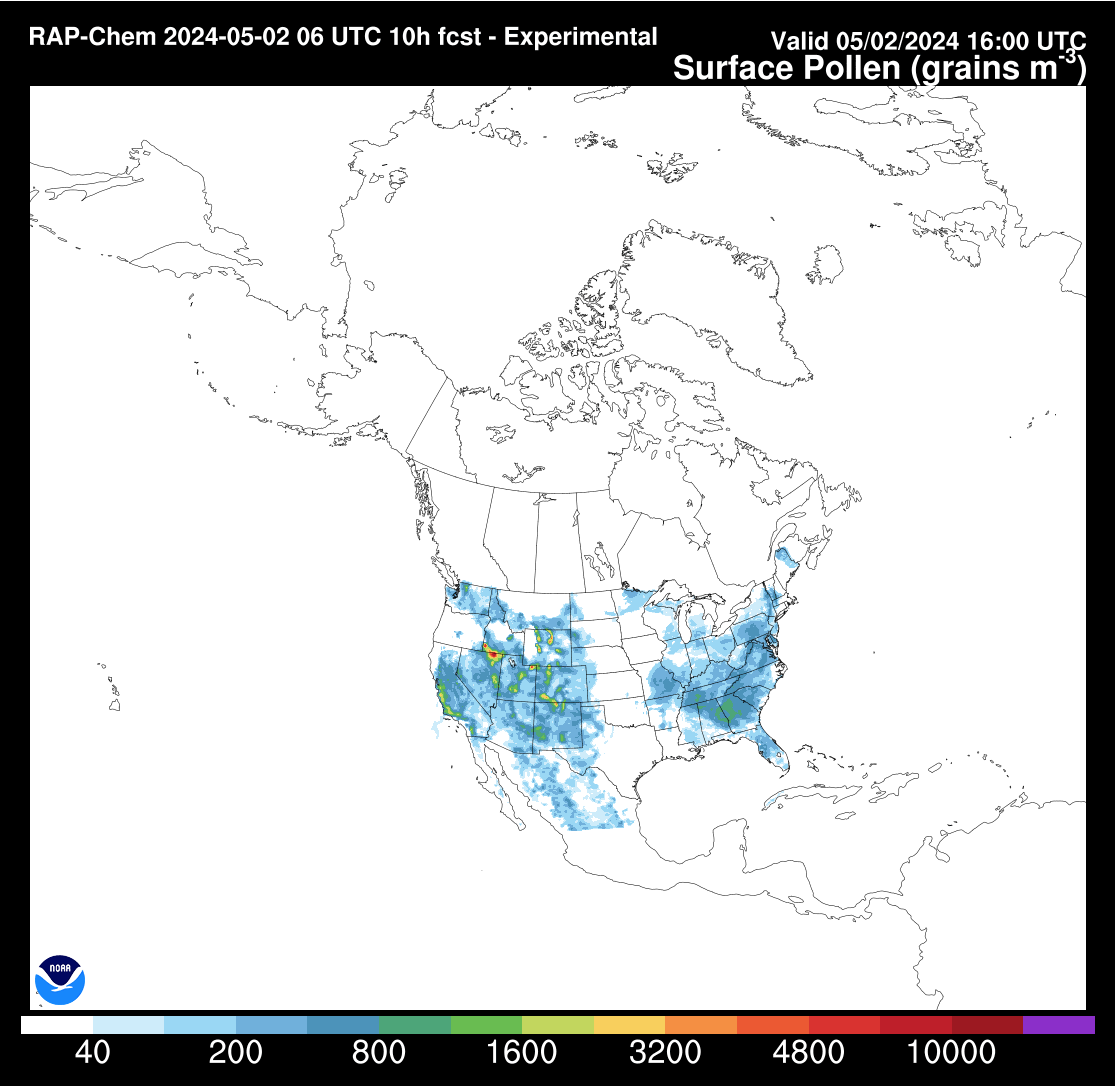Spring is in the air--and in your nose, eyes, and lungs!

 More than 50 million Americans suffer from seasonal allergies due to airborne pollen, according to the American College of Allergy, Asthma & Immunology. Pollen is an equal opportunity irritant, particularly during spring, summer and fall when wind-blown pollen from trees, grasses and weeds can be at their highest levels. Accurate pollen forecasts could help sufferers reduce their exposure the same way that they might on high ozone days. The image to the right shows the pollen forecast for the afternoon of Thursday, May 2.
More than 50 million Americans suffer from seasonal allergies due to airborne pollen, according to the American College of Allergy, Asthma & Immunology. Pollen is an equal opportunity irritant, particularly during spring, summer and fall when wind-blown pollen from trees, grasses and weeds can be at their highest levels. Accurate pollen forecasts could help sufferers reduce their exposure the same way that they might on high ozone days. The image to the right shows the pollen forecast for the afternoon of Thursday, May 2.
Current commercially produced pollen forecasts in the U.S. are based on past seasonal pollen counts and local weather conditions. These forecasts don’t predict the transport of pollen or include its impact on weather.
GSL and CIRES researchers are working on an experimental pollen forecast; the first pollen forecast in the U.S. that can predict the impact of pollen on the weather, and the weather on pollen. The model has been producing pollen forecasts since the summer of 2022, and qualitative comparisons with some commercial forecasts show that the model performs similarly.
“Pollen and its associated allergies are important components to people’s everyday lives,” says GSL and CIRES researcher Jordan Schnell. “With real-time predictions of pollen and where it is transported, people can adjust their outdoor activities, medications, and take precautions to ensure their wellbeing.”
The pollen forecast is a module in the experimental Rapid-Refresh Chemistry (RAP-Chem) weather and atmospheric chemistry prediction system. With pollen data supplied by the University of Michigan, the model produces a 48-hour air quality forecast once a day on a 13 km grid that includes both coarse and fine pollen grains. Fine pollen is created from the rupturing of coarse grains and can be easier to inhale, making your nose run more.
Access the data: https://rapidrefresh.noaa.gov/RAPchem/
Scroll through the fields on the left side of the grid until you see “Surface Coarse Pollen” or “Surface Fine Pollen.” Click the checkmark under “Loop” for a video of the pollen forecast. To see a specific hour, click on the number that shows how far out the prediction will be.
The model shows a day and night cycle in pollen emissions and abundance in the air. Winds usually relax overnight, and so do pollen emissions. Pollen can also have impacts on the weather. A pollen grain can serve as a nuclei for water vapor to condense upon to form a cloud. It can scatter or absorb sunlight. Rain tends to cleanse the air and reduce pollen counts. But, thunderstorms can make asthma worse because cold downdrafts concentrate pollen particles, then they get caught in updrafts where humidity is high. In the storm clouds, wind, humidity, and even lightning can break up the particles making them smaller and easier to inhale.
Videos
The animations display an experimental 48-hour RAP-Chem forecast for course pollen on April 26, 2024.
Fine pollen at the surface. Fine pollen is formed when course pollen ruptures.
Both particle types can be transported and interact with radiation and/or clouds.
GSL and CIRES researchers are engaging with stakeholders like the Center for Disease Control to look at previous years’ RAP-Chem pollen forecasts to correlate pollen predictions with epidemiological factors. Researchers are now working to add coarse and fine pollen emissions (separately for trees, grasses, and weeds) to the experimental 3 km Rapid Refresh Forecast System.
